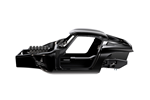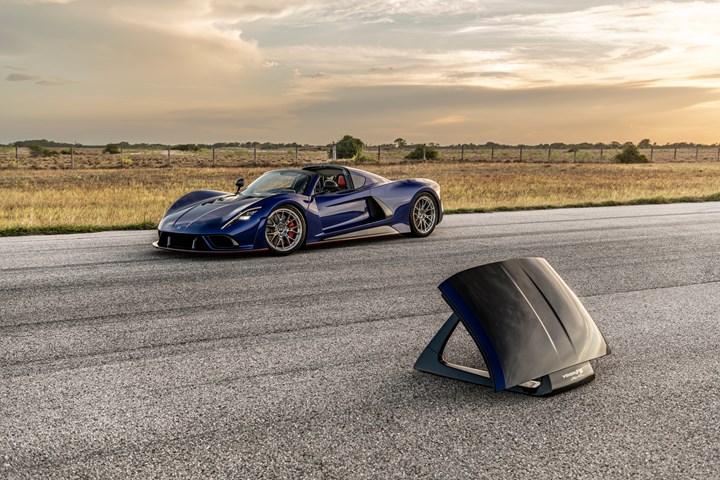Hennessey Performance adds a roadster to the Venom F5 line
Last year it was the Coupe. This year it’s a quick, open-air hypercar with a removable carbon fiber roof.
What do you do with the carbon fiber top from your Hennessey Venom F5 Roadster? Why, put it on a specially designed stand, also made with carbon fiber. Photo Credit: Hennessey Performance.
While seemingly every automotive company is rolling out with an electric vehicle (EV) that is either sumptuous, quick or both, Hennessey Performance (Seely, Texas) has launched a new variant of the 1,817-horsepower, 6.6-liter, twin-turbo V8-powered Venom F5, this one a roadster.
Like the Coupe that was introduced last year, the gasoline-powered hypercar has a carbon fiber chassis and body panels. (There is, however, a glass viewing window that allows one to see the engine — but as the glass is contained in a carbon fiber frame, it arguably qualifies.)
Consequently, the vehicle, which measures 183.7 inches long x 77.6 inches wide x 44.5 inches high, has a mass of merely 3,098 pounds, a massive V8 notwithstanding.
To make this a proper roadster, there is a removable carbon fiber roof that features an Alcantara headliner and is held in place with four quick-release bolts and two high-strength latches. The roof weighs 18 pounds, so this isn’t a matter of having to lug something; those who own vehicles with removable panels are sometimes faced with the question of what to do with them when they are not affixed to the vehicle.
But where do you put it? Hennessey designers have devised two solutions. One is a travel bag. This is not entirely an unusual solution, as, for example, the Ford Bronco has storage bags for its removable body panels. However, while the Hennessey bags are made with Merino wool, the Ford bags are vinyl with a felt inner liner.
The second solution is befitting of a vehicle that is priced at $3 million. Remove the panel and mount it on a carbon fiber sculptural pedestal. The pedestal borrows design cues from the car (e.g., the side profile is meant to echo the air intake on the F5’s bodyside).
The Venom F5 Roadster, is expected to have a top speed of in excess of 300 miles per hour. Hennessey is building 30 of the gasoline-powered hypercars.
Related Content
-
Prepreg compression molding supports higher-rate propeller manufacturing
To meet increasing UAV market demands, Mejzlik Propellers has added a higher-rate compression molding line to its custom CFRP propeller capabilities.
-
An outlook on China’s carbon fiber market
This analysis sheds additional light on the insights, observations and data shared in ATA Industrial Group’s carbon fiber market report on global and Chinese industry players.
-
Co-molding SMC with braided glass fiber demonstrates truck bed potential
Prepreg co-molding compound by IDI Composites International and A&P Technology enables new geometries and levels of strength and resiliency for automotive, mobility.

.jpg;width=70;height=70;mode=crop)















